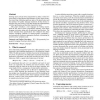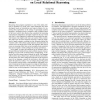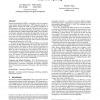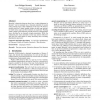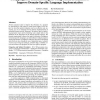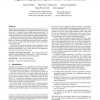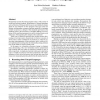ICFP
2010
ACM
14 years 1 months ago
2010
ACM
Existing macro systems force programmers to make a choice between clarity of specification and robustness. If they choose clarity, they must forgo validating significant parts of ...
ICFP
2010
ACM
14 years 1 months ago
2010
ACM
Reasoning about program equivalence is one of the oldest problems in semantics. In recent years, useful techniques have been developed, based on bisimulations and logical relation...
ICFP
2010
ACM
14 years 1 months ago
2010
ACM
Nested data-parallelism (NDP) is a declarative style for programming irregular parallel applications. NDP languages provide language features favoring the NDP style, efficient com...
ICFP
2010
ACM
14 years 1 months ago
2010
ACM
The leading implementations of graph reduction all target conventional processors designed for low-level imperative execution. In this paper, we present a processor specially desi...
ICFP
2010
ACM
14 years 1 months ago
2010
ACM
' abstraction theorem shows how a typing judgement in System F can be translated into a relational statement (in second order predicate logic) about inhabitants of the type. ...
ICFP
2010
ACM
14 years 1 months ago
2010
ACM
Partial evaluation aims to improve the efficiency of a program by specialising it with respect to some known inputs. In this paper, we show that partial evaluation can be an effec...
ICFP
2010
ACM
14 years 1 months ago
2010
ACM
We present a novel approach to regular, multi-dimensional arrays in Haskell. The main highlights of our approach are that it (1) is purely functional, (2) supports reuse through s...
ICFP
2010
ACM
14 years 1 months ago
2010
ACM
Bidirectional transformations provide a novel mechanism for synchronizing and maintaining the consistency of information between input and output. Despite many promising results o...
ICFP
2010
ACM
14 years 1 months ago
2010
ACM
We present a type and effect system for flow analysis that makes essential use of higher-ranked polymorphism. We show that, for higher-order functions, the expressiveness of highe...
ICFP
2010
ACM
14 years 1 months ago
2010
ACM
Programmers reason about their programs using a wide variety of formal and informal methods. Programmers in untyped languages such as Scheme or Erlang are able to use any such met...
